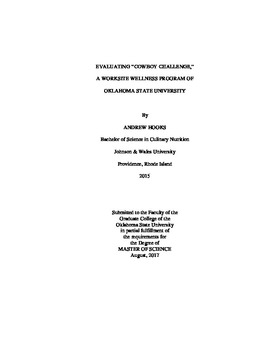| dc.description.abstract | To evaluate the effectiveness of the Cowboy Challenge program.Design: Cohort study with pre-/post design. Setting: Oklahoma State University – Stillwater CampusParticipants: The program was available to all benefits eligible employees. Ninety one employees participated, ranging from 22 to 63 years old. Intervention: 12-week team based worksite wellness program, including exercise and nutrition components. A minimum of 150 minutes of physical activity each week was required (including at least two - 45 minute sessions with a provided personal trainer). The nutrition component included 3 weeks of mandatory food journaling and 3 education meetings.Main Outcome Measures: The effectiveness of the program was evaluated based on changes in blood lipid panel, fasting blood glucose, diastolic/systolic pressure, Body Mass Index, abdominal girth, cardiovascular fitness (measured by Rockport 1 mile walk and Modified Naughton protocol), muscular endurance (measured by YMCA bench press) and flexibility (measured by trunk flexion). An online survey was also conducted to evaluate participant perceptions of the program. Analysis: Paired t-tests (? = .05)Results: At baseline, mean values for blood lipids (triglycerides, total cholesterol, LDL, and HDL) were within normal limits and 72.5% of participants were overweight or obese. After completion of the program, small but significant improvements were found in BMI (p=.004), and weight decreased approximately 0.7 kg (p=.003). Flexibility, muscular endurance and cardiovascular fitness all improved (p<.001 each). Diastolic blood pressure significantly decreased, systolic blood pressure tended to decrease (p=.08) but was not significant. Less than one third (n=26) of the participants responded to the survey. Almost all (25/26) reported that the Cowboy Challenge was beneficial; the most reported benefit was improved cardiovascular fitness.Conclusions/Implications: The program effectively improved the fitness (cardiovascular fitness, muscular endurance, and flexibility) of participants and resulted in slight but significant weight loss. No changes were found in blood lipids, possibly because they were already within normal limits. These results were generally consistent with similar studies. | |
